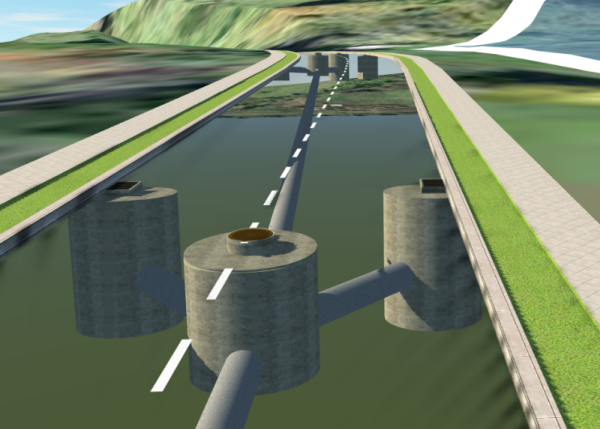About Drainage Networks
Model a drainage network, including outfalls, using analysis-driven design and spacing rules. Draft a design based on a road or build out a network with structures apart from a road. Refine and re-size network structures. Manage rainfall content data and analyze inlets and inspect hydraulic performance of selected pipe runs. Generate a table showing quantities of materials needed.

Two ways to build a drainage network:
Select a component road and right-click, then expland the Drainage menu and click Add Drainage Network. This will automatically generate an initial, draft drainage layout for the selected component road. Adjust the drainage structures and materials, including outfalls, as needed.
Note: Inlets are placed only if the selected road uses a road style with a Curb track.
OR:
- Click Create
 Drainage
Drainage 
 (Drainage Network), to create a network anywhere, apart from a road. Add pipes, inlets, manholes or outfalls, one or a few at a time. You can connect these structures to a road-based network.
(Drainage Network), to create a network anywhere, apart from a road. Add pipes, inlets, manholes or outfalls, one or a few at a time. You can connect these structures to a road-based network.
You choose component part structures from a part catalog, which can be shared with Autodesk Civil 3D. Drainage Design supplies a default catalog. Using Infrastructure Content Authoring, you can create a custom component part catalog.
When you are satisfied with the layout, including the location of outfalls, run ![]() . This tool re-analyzes the network and adjusts pipe diameters, slopes, and the size of underground structures affected by your changes. It is especially useful if you move an outfall.
. This tool re-analyzes the network and adjusts pipe diameters, slopes, and the size of underground structures affected by your changes. It is especially useful if you move an outfall.
 resizes the structures connected to a single network, including a network apart from a component road. Use Highlight Drainage Network to see a network's extents.
resizes the structures connected to a single network, including a network apart from a component road. Use Highlight Drainage Network to see a network's extents.- The component road version, located on the selected road's context menu, re-sizes structures connected to all networks along the road.
Analysis-Driven Design and Sizing of Structures
Drainage Design uses industry standard rules and calculations to provide analysis-driven design. These data and standards include watershed flow data, Rational Runoff calculations, Road Slopes/Manning's coefficients, and Intensity-Duration-Frequency (IDF) Rainfall coefficients. You can vary the AEP setting (default = 1/10) to examine pipe runs in different storm level conditions. You can override Drainage Design decisions to suit the needs of your model. You see these data in-canvas or on a drainage structure's attributes stack.
Manage Rainfall Content Data
Using ![]() , Rainfall content, you can assign model-specific rainfall data for more accurate drainage design. It provides you with three, pre-defined sample content templates, which you can customize: BDE, Tabular, and ANZ.Polynomial (used in Australia and New Zealand).
, Rainfall content, you can assign model-specific rainfall data for more accurate drainage design. It provides you with three, pre-defined sample content templates, which you can customize: BDE, Tabular, and ANZ.Polynomial (used in Australia and New Zealand).
Quantities of Materials Needed
For a selected component road with a pavement drainage network, in the Analysis Hub, click the Show Road Quantities icon ![]() in the Material Quantities tool to calculate quantities of culverts, inlets, manholes, pipelines and outfalls.
in the Material Quantities tool to calculate quantities of culverts, inlets, manholes, pipelines and outfalls.
